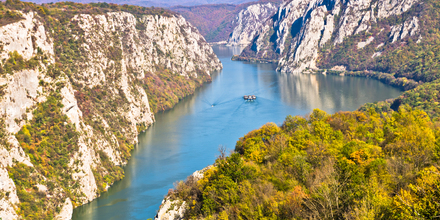Biodiversity
Our Work
Latest in Biodiversity
-

Natura 2000 and Jobs – Scoping the Evidence
The European Natura 2000 network provides job opportunities in sectors ranging from conservation and restoration, agriculture, forestry, fisheries to tourism, recreation, and health.
-
Access to Nature Reduces Health Inequalities: An IEEP Briefing
Improving access to nature can help address health and social challenges across Europe and reduce health inequalities.
-
Wildlife crime and the EU
Wildlife crime threatens global biodiversity. The EU is both a destination and a transit region for illegally-traded products. A new study for the European Parliament summarises the situation in Europe and offers policy recommendations in view of the upcoming EU Action Plan. A set of in-depth case studies outline the situation in five EU countries.
-
The Manual: Chapter 1 - Policy framework
This is a chapter of IEEP’s Manual of European Environmental Policy. In this chapter, the reader is introduced to European environmental policy, EU institutions and agencies, and the development of EU treaties.
-
On the path to a circular economy
Read the lastest edition of our newsletter for our views on the circular economy package and much more.
-
High Nature Value farming throughout EU-27 and its financial support under the CAP
This study reviews Member States’ estimates of the extent of HNV farmland and use of RDP measures and the CMEF indicators, then identifies future priorities for CAP support for HNV farming and discusses the support opportunities under the reformed CAP. It offers detailed new evidence about the combined effect of Pillar 1 and Pillar 2 CAP payments on the economic and environmental viability of a typical HNV farming system in three Member States.
-
Environmental policy and the UK’s review of the EU Balance of Competences
The UK Government’s Balance of Competences review has now taken evidence on 25 subject areas, including the 6 with the most relevance for the Environment. We take stock of the IEEP’s contributions, and consider what a possible UK renegotiation might mean for the environment.
-
Options for sustainable food and agriculture in the EU
How should Europe respond to the increased demands on our food and agriculture systems arising from global population growth, changing diets, and competing demands on agricultural land? This report offers a view on how the EU could play a role in meeting these challenges in the coming decades and sets out some of the options which merit particular attention.
-
Europe’s role in feeding the world in 2050
IEEP presents views on how Europe should respond to the increased demands on our food and agriculture systems arising from global population growth, changing diets, and competing demands on agricultural land.
-
Interactions between climate change and agriculture; and between biodiversity and agriculture in Europe
What should be Europe’s role in feeding the world in 2050? This IEEP report for the European Parliament describes options for increasing the productivity of European agriculture whilst adapting to climate change, reducing emissions, and providing biodiversity and ecosystem service benefits from agriculture.
-
Sectoral resource mobilisation to implement global biodiversity targets
There is an urgent need to find sufficient resources to enable developing countries to implement the global targets for biodiversity by 2020. Financing the conservation and sustainable use of biodiversity from different sectoral funding flows can complement global biodiversity financing.
-
Ecosystem services of boreal mires and peatlands in Finland
Mire ecosystems are well-known for their unique species and habitats of high conservation value and they also provide a range of benefits to our societies and economies. This publication outlines the results of a pioneering project that aimed to identify and valuate ecosystem services provided by pristine mires and managed peatlands in Finland.
-
Does the EU benefit the UK environment?
This report considers how environmental policy in the EU effects the UK and looks at some alternatives. Overall the impact within the environmental domain can be judged to be strongly positive to the UK. The action taken has been well balanced, with benefits for human health and welfare and the sustainability of the economy as well as the environment itself.
-
Incorporating biodiversity and ecosystem service values into national strategies and action plans
This guidance document has been prepared to support practitioners of National Biodiversity Strategies and Action Plans to update their plans to incorporate biodiversity and ecosystem service values. Six in depth country case studies provide common lessons of good practice.
-
Webinar: Incorporating biodiversity into national strategies and action plans
IEEP has just produced a roadmap and guidance document to help practitioners to incorporate biodiversity and ecosystem values into their NBSAPs. See case study examples and tune into the webinars on June 5 and 7.
-
Land as an Environmental Resource
How can we meet the different and often conflicting demands we make on our limited supply of rural land in Europe? A more strategic approach to the way in which land is used is needed than has been the case in the past. This report for DG Environment looks at the data, the challenges and the policy options for Europe.
-
Socio-economic importance of ecosystem services in the Nordic countries
New TEEB-inspired regional assessment (published on 31 January) shows that nature and its ecosystem services are of high socio-economic significance for the Nordic countries. In order to be truly sustainable, Nordic economic systems need to build on a more comprehensive appreciation and understanding of the value of natural capital.
-
Exploring key priorities and actions for the 7th EAP
This policy paper examines how the forthcoming 7EAP can contribute to protecting natural systems and improving the way in which we use natural resources. It also examines a number of cross-cutting actions needed to support the priorities of the 7EAP and ensure better delivery of EU environment policy.
-
What do we mean by Green Economy?
What is the Green Economy? What policy actions can contribute to achieving it? And how have EU-funded research projects supported these actions?
-
Green Economy in the European Union
Elements of the green economy concept are relatively well integrated in EU strategic documents - but the focus is on achieving green/sustainable growth, rather than achieving a ‘green economy’.
Highlights
-

Access to Nature Reduces Health Inequalities: An IEEP Briefing
Improving access to nature can help address health and social challenges across Europe and reduce health inequalities.
-

Wildlife crime and the EU
Wildlife crime threatens global biodiversity. The EU is both a destination and a transit region for illegally-traded products. A new study for the European Parliament summarises the situation in Europe and offers policy recommendations in view of the upcoming EU Action Plan. A set of in-depth case studies outline the situation in five EU countries.
-

Sectoral resource mobilisation to implement global biodiversity targets
-

Does the EU benefit the UK environment?
